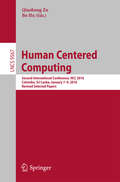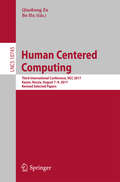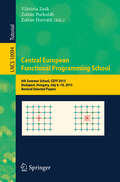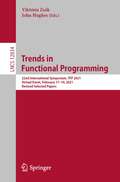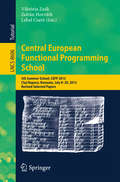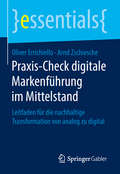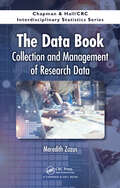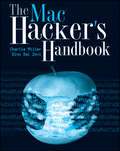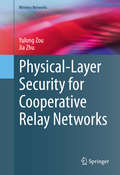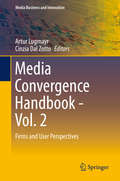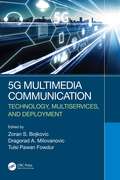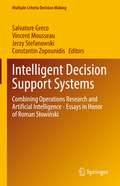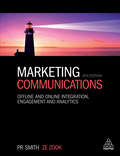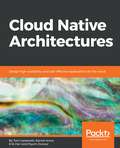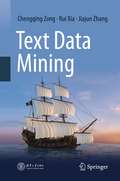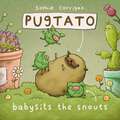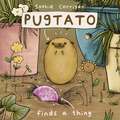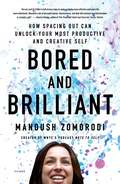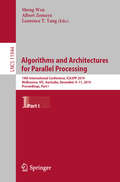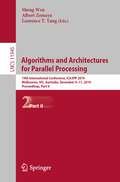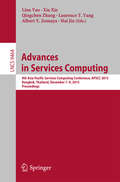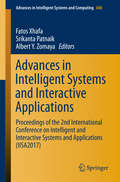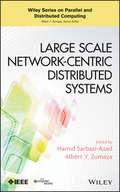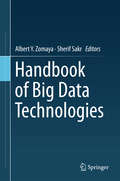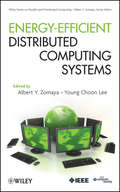- Table View
- List View
Human Centered Computing
by Qiaohong Zu Bo HuThis book constitutes revised selected papers from thethoroughly refereed proceedings of the Second International Human CenteredComputing Conference, HCC 2016, that consolidated and further develops thesuccessful ICPCA/SWS conferences on Pervasive Computing and the NetworkedWorld, and which was held in Colombo, Sri Lanka, in January 2016. The 58 full papers and 30 short papers presented in thisvolume together with one keynote talk were carefully reviewed and selected from211 submissions. These proceedings present research papers investigating into avariety of aspects towards human centric intelligent societies. They cover thecategories: infrastructure and devices; service and solution; data andknowledge; and community.
Human Centered Computing
by Qiaohong Zu Bo HuThis book constitutes revised selected papers from the thoroughly refereed proceedings of the Third International Human Centered Computing Conference, HCC 2017, that consolidated and further develops the successful ICPCA/SWS conferences on Pervasive Computing and the Networked World, and which was held in Kazan, Russia, in August 2017. The 48 full and 20 short papers presented in this book together with 2 invited keynotes were carefully reviewed and selected from numerous submissions. This proceedings present recent advances in human machine interfaces, wireless and mobile network technologies, and data analytics, which make computer services truly human-centric.
Central European Functional Programming School: 6th Summer School, CEFP 2015, Budapest, Hungary, July 6–10, 2015, Revised Selected Papers (Lecture Notes in Computer Science #10094)
by Viktória Zsók Zoltán Porkoláb Zoltán HorváthThis volume presents the revised lecture notes of selected talks given at the 6th Central European Functional Programming School, CEFP 2015, held in July 2015, in Budapest, Hungary.The 10 revised full papers presented were carefully reviewed and selected. The lectures covered a wide range of functional programming and C++ programming subjects.
Trends in Functional Programming: 22nd International Symposium, TFP 2021, Virtual Event, February 17–19, 2021, Revised Selected Papers (Lecture Notes in Computer Science #12834)
by Viktória Zsók John HughesThis book constitutes revised selected papers from the 22nd International Symposium on Trends in Functional Programming, TFP 2021, which was held virtually in February 2020. The 6 full papers presented in this volume were carefully reviewed and selected from 18 submissions. They were organized in topical sections about nested parallelism, semantics, task-oriented programming and modelling, translating, proving functional programs. Chapter ‘Dataset Sensitive Autotuning of Multi-Versioned Code based on Monotonic Properties’ is available open access under a Creative Commons Attribution 4.0 International License via link.springer.com. Chapter ‘High-level Modelling for Typed Functional Programming’ is available open access under a Creative Commons Attribution 4.0 International License via link.springer.com.
Central European Functional Programming School: 5th Summer School, CEFP 2013, Cluj-Napoca, Romania, July 8-20, 2013, Revised Selected Papers (Lecture Notes in Computer Science #8606)
by Viktória Zsók Zoltán Horváth Lehel CsatóThis volume presents the revised lecture notes of selected talks given at the Fifth Central European Functional Programming School, CEFP 2013, held in July 2013 in Cluj-Napoca, Romania. The 14 revised full papers presented were carefully reviewed and selected. The lectures cover a wide range of distributed and multicore functional programming subjects. The last 5 papers are selected papers of the PhD Workshop organized for the participants of the summer school.
Praxis-Check digitale Markenführung im Mittelstand: Leitfaden für die nachhaltige Transformation von analog zu digital (essentials)
by Arnd Zschiesche Oliver ErrichielloOliver Errichiello und Arnd Zschiesche erklären in diesem essential das „Phänomen Marke“ zunächst grundlegend und zeitunabhängig, gerade um die gängigen, kurzfristigen digitalen Marketingmoden zu entkräften – denn „Überzeugen“ folgt im Netz den identischen Prinzipien wie am Marktstand. In einem zweiten Schritt unterstützen sie Markenverantwortliche dabei, die Faktoren zu operationalisieren, die eine Marke im Netz langfristig erfolgreich machen, und geben Schritt für Schritt einen praxisorientierten Positionierungsbauplan. Auf wissenschaftlicher Basis verdeutlichen die Autoren, dass starke Marken niemals Empfänger, sondern immer Sender sind – insbesondere dann, wenn die Welt um uns herum immer unübersichtlicher wird.
The Data Book: Collection and Management of Research Data (Chapman & Hall/CRC Interdisciplinary Statistics)
by Meredith ZozusThe Data Book: Collection and Management of Research Data is the first practical book written for researchers and research team members covering how to collect and manage data for research. The book covers basic types of data and fundamentals of how data grow, move and change over time. Focusing on pre-publication data collection and handling, the text illustrates use of these key concepts to match data collection and management methods to a particular study, in essence, making good decisions about data. The first section of the book defines data, introduces fundamental types of data that bear on methodology to collect and manage them, and covers data management planning and research reproducibility. The second section covers basic principles of and options for data collection and processing emphasizing error resistance and traceability. The third section focuses on managing the data collection and processing stages of research such that quality is consistent and ultimately capable of supporting conclusions drawn from data. The final section of the book covers principles of data security, sharing, and archival. This book will help graduate students and researchers systematically identify and implement appropriate data collection and handling methods.
The Mac® Hacker's Handbook
by Dino Dai Zovi Charlie MillerAs more and more vulnerabilities are found in the Mac OS X (Leopard) operating system, security researchers are realizing the importance of developing proof-of-concept exploits for those vulnerabilities. This unique tome is the first book to uncover the flaws in the Mac OS X operating system-and how to deal with them. Written by two white hat hackers, this book is aimed at making vital information known so that you can find ways to secure your Mac OS X systems, and examines the sorts of attacks that are prevented by Leopard's security defenses, what attacks aren't, and how to best handle those weaknesses.
Physical-Layer Security for Cooperative Relay Networks
by Yulong Zou Jia ZhuThis book presents physical-layer security as a promising paradigm for achieving the information-theoretic secrecy required for wireless networks. It explains how wireless networks are extremely vulnerable to eavesdropping attacks and discusses a range of security techniques including information-theoretic security, artificial noise aided security, security-oriented beamforming, and diversity assisted security approaches. It also provides an overview of the cooperative relaying methods for wireless networks such as orthogonal relaying, non-orthogonal relaying, and relay selection. Chapters explore the relay-selection designs for improving wireless secrecy against eavesdropping in time-varying fading environments and a joint relay and jammer selection for wireless physical-layer security, where a relay is used to assist the transmission from the source to destination and a friendly jammer is employed to transmit an artificial noise for confusing the eavesdropper. Additionally, the security-reliability tradeoff (SRT) is mathematically characterized for wireless communications and two main relay-selection schemes, the single-relay and multi-relay selection, are devised for the wireless SRT improvement. In the single-relay selection, only the single best relay is chosen for assisting the wireless transmission, while the multi-relay selection invokes multiple relays for simultaneously forwarding the source transmission to the destination. Physical-Layer Security for Cooperative Relay Networks is designed for researchers and professionals working with networking or wireless security. Advanced-level students interested in networks, wireless, or privacy will also find this book a useful resource.
Media Convergence Handbook - Vol. 1
by Cinzia Dal Zotto Artur LugmayrThe Media Convergence Handbook sheds new light on the complexity of media convergence and the related business challenges. Approaching the topic from a managerial, technological as well as end-consumer perspective, it acts as a reference book and educational resource in the field. Media convergence at business level may imply transforming business models and using multiplatform content production and distribution tools. However, it is shown that the implementation of convergence strategies can only succeed when expectations and aspirations of every actor involved are taken into account. Media consumers, content producers and managers face different challenges in the process of media convergence. Volume I of the Media Convergence Handbook encourages an active discourse on media convergence by introducing the concept through general perspective articles and addressing the real-world challenges of conversion in the publishing, broadcasting and social media sectors.
5G Multimedia Communication: Technology, Multiservices, and Deployment
by Zoran S. Bojkovic, Dragorad A. Milovanovic, and Tulsi Pawan FowdurIn bringing to the readers the book 5G Multimedia Communication: Technology, Multiservices and Deployment, the aim is to present current work and direction on the challenging subject of multimedia communications, with theoretical and practical roots. The past two decades have witnessed an extremely fast evolution of mobile cellular network technology. The fifth generation of mobile wireless systems has achieved the first milestone toward finalization and deployment by 2020. This is vital to the development of future multimedia communications. Also, it is necessary to consider 5G technology from the performance point of view by analyzing network capabilities to the operator and to the end user in terms of data rate, capacity, coverage, energy efficiency, connectivity and latency. The book is divided into three major parts with each part containing four to seven chapters: • Critical enabling technology • Multiservices network • Deployment scenarios The first part discusses enabling technologies, such as green communication, channel modeling, massive and distributed MIMO and ML-based networks. In the second part, different methodologies and standards for multiservices have been discussed. Exclusive chapters have been dedicated to each of the open research challenges such as multimedia operating in 5G environment, network slicing optimization, mobile edge computing, mobile video multicast/broadcast, integrated satellite and drone communication. The third part paved the way to deployment scenarios for different innovative services including integration of a multienergy system in smart cities, intelligent transportation systems, 5G connectivity in the transport sector, healthcare services, 5G edge-based video surveillance and challenges of connectivity for massive IoT in 5G and beyond systems. The book is written by experts in the field who introduced scientific and engineering concepts, covering the 5G multimedia communication areas. The book can be read cover-to-cover or selectively in the areas of interest for the readers. Generally, the book is intended for novel readers who could benefit from understanding general concepts, practitioners who seek guidance into the field and senior-level as well as graduate-level engineering students in understanding the process of today’s wireless multimedia communications.
Intelligent Decision Support Systems: Combining Operations Research and Artificial Intelligence - Essays in Honor of Roman Słowiński (Multiple Criteria Decision Making)
by Constantin Zopounidis Jerzy Stefanowski Vincent Mousseau Salvatore GrecoThis book presents a collection of essays written by leading researchers to honor Roman Słowiński’s major scholarly interests and contributions. He is well-known for conducting extensive research on methodologies and techniques for intelligent decision support, where he combines operational research and artificial intelligence. The book reconstructs his main contributions, presents cutting-edge research and provides an outlook on the most promising and advanced domains of computer science and multiple criteria decision aiding. The respective chapters cover a wide range of related research areas, including decision sciences, ordinal data mining, preference learning and multiple criteria decision aiding, modeling of uncertainty and imprecision in decision problems, rough set theory, fuzzy set theory, multi-objective optimization, project scheduling and decision support applications. As such, the book will appeal to researchers and scholars in related fields.
Marketing Communications
by Ze Zook Pr SmithMarketing Communications provides a comprehensive overview of every aspect of marketing communications, from social media, advertising, PR and sponsorship to direct selling and merchandizing. It presents modern marketing communications theories and tools in an accessible way so readers can fully understand the landscape and achieve better results. With a plethora of examples and case studies, as well as online support material for lecturers and students, this essential textbook will guide students and practitioners through everything they need to know about the changing face of marketing. This fully updated 6th edition of Marketing Communications features more of the underpinning theory whilst building on its impressive reputation as a leading practical textbook on the subject. Case studies and anecdotes from companies such as Campbell's Soup, Spotify, Paypal, Kraft and Nike focus on recent digital developments to bring the latest marketing tools to life. With a particular emphasis on analytics, engagement and integration, it addresses the integrated offline and online with social media approach to reflect the current state of play for marketing communications experts.
Cloud Native Architectures: Design high-availability and cost-effective applications for the cloud
by Piyum Zonooz Erik Farr Kamal Arora Tom LaszewskiLearn and understand the need to architect cloud applications and migrate your business to cloud efficientlyKey FeaturesUnderstand the core design elements required to build scalable systemsPlan resources and technology stacks effectively for high security and fault toleranceExplore core architectural principles using real-world examplesBook DescriptionCloud computing has proven to be the most revolutionary IT development since virtualization. Cloud native architectures give you the benefit of more flexibility over legacy systems. To harness this, businesses need to refresh their development models and architectures when they find they don’t port to the cloud. Cloud Native Architectures demonstrates three essential components of deploying modern cloud native architectures: organizational transformation, deployment modernization, and cloud native architecture patterns.This book starts with a quick introduction to cloud native architectures that are used as a base to define and explain what cloud native architecture is and is not. You will learn what a cloud adoption framework looks like and develop cloud native architectures using microservices and serverless computing as design principles. You’ll then explore the major pillars of cloud native design including scalability, cost optimization, security, and ways to achieve operational excellence. In the concluding chapters, you will also learn about various public cloud architectures ranging from AWS and Azure to the Google Cloud Platform.By the end of this book, you will have learned the techniques to adopt cloud native architectures that meet your business requirements. You will also understand the future trends and expectations of cloud providers.What you will learnLearn the difference between cloud native and traditional architectureExplore the aspects of migration, when and why to use itIdentify the elements to consider when selecting a technology for your architectureAutomate security controls and configuration managementUse infrastructure as code and CICD pipelines to run environments in a sustainable mannerUnderstand the management and monitoring capabilities for AWS cloud native application architecturesWho this book is forCloud Native Architectures is for software architects who are keen on designing resilient, scalable, and highly available applications that are native to the cloud.
Text Data Mining
by Chengqing Zong Rui Xia Jiajun ZhangThis book discusses various aspects of text data mining. Unlike other books that focus on machine learning or databases, it approaches text data mining from a natural language processing (NLP) perspective. The book offers a detailed introduction to the fundamental theories and methods of text data mining, ranging from pre-processing (for both Chinese and English texts), text representation and feature selection, to text classification and text clustering. It also presents the predominant applications of text data mining, for example, topic modeling, sentiment analysis and opinion mining, topic detection and tracking, information extraction, and automatic text summarization. Bringing all the related concepts and algorithms together, it offers a comprehensive, authoritative and coherent overview. Written by three leading experts, it is valuable both as a textbook and as a reference resource for students, researchers and practitioners interested in text data mining. It can also be used for classes on text data mining or NLP.
Pugtato Babysits the Snouts
by ZondervanWhat do you get when you cross imaginative and loveable characters, enchanting and inspiring illustrations and a giggle-inducing story? ...Pugtato, a simple, good spud and a hilarious mashup of pet and vegetable characters by the inimitable illustrator Sophie Corrigan! Join Pugtato as he takes on the job of babysitting the Brussels Snouts.Pugtato thinks babysitting will be easy … how much trouble can baby Brussels Snouts get into? But as the day unfolds, the rambunctious little Snouts decide to show Pugtato they are not little babies, and prove that size doesn&’t matter when it comes to having lots of fun with your good spuddies.Pugtato Babysits the Snouts delivers:A delightful, giggle-inducing, rhyming, read-aloud story perfect for kids ages 4-8Imaginative, silly pet and vegetable mashups such as Pugtato, Tomatoad, Carrat, Cowbbage, Croccoli, Unicorn on the Cob and more!A beautiful, eye-catching cover, rich with color and embossed textureYoung children will learn invaluable lessons from Pugtato about:FriendshipAcceptanceResponsibilityCreativityYou&’ll also want to follow Pugtato&’s adventures in Pugtato, Let&’s Be Best Spuddies, Pugtato Finds a Thing, and Pugtato and Friends Audio Collection: 3 Books in 1.
Pugtato Finds a Thing
by ZondervanWhat do you get when you cross imaginative and loveable characters, enchanting and inspiring illustrations and a giggle-inducing story? Pugtato, a simple, good spud and a hilarious mashup of pet and vegetable characters by the inimitable illustrator Sophie Corrigan! Join Pugtato and his cute and quirky spuddies in this heartwarming picture book that celebrates the power of friendship, compassion, and believing in your own unique gifts.When Pugtato&’s simple, quiet life is disrupted after he digs up a strange object in his garden, he enlists his best &“spuddies&” to help (they are more clever than he is, after all). Tweetroot is certain it&’s a new egg for her nest. Tomatoad is quite sure it&’s a toy just for him. And Purrsnip simply won&’t stop scratching it! Luckily, Pugtato has another very special spuddy to ask …Pugtato Finds a Thing delivers:A delightful, giggle-inducing, rhyming , read-aloud story perfect for kids ages 4-8Imaginative, silly pet and vegetable mashups such as Pugtato, Tomatoad, Carrat, Cowbbage, Croccoli, Unicorn on the Cob and more!A beautiful eye-catching cover rich with color Young children will learn invaluable lessons from Pugtato about:FriendshipCompassionAcceptanceCreativity You&’ll also want to follow Pugtato&’s adventures in Pugtato Babysits the Snouts, Pugtato, Let&’s Be Best Spuddies, and Pugtato and Friends Audio Collection: 3 Books in 1.
Bored and Brilliant: How Spacing Out Can Unlock Your Most Productive and Creative Self
by Manoush Zomorodi"Bored and Brilliant shows the fascinating side of boredom. Manoush Zomorodi investigates cutting-edge research as well as compelling (and often funny) real-life examples to demonstrate that boredom is actually a crucial tool for making our lives happier, more productive, and more creative. What’s more, the book is crammed with practical exercises for anyone who wants to reclaim the power of spacing out – deleting the Two Dots app, for instance, or having a photo-free day, or taking a 'fakecation'." —Gretchen Rubin, author of #1 NYT Bestseller The Happiness Project"Bored and Brilliant is full of easy steps to make each day more effective and every life more intentional. Manoush’s mix of personal stories, neuroscience, and data will convince you that boredom is actually a gift." —Charles Duhigg, author of The Power of Habit and Smarter, Faster, BetterIt’s time to move “doing nothing” to the top of your to-do list.In 2015 Manoush Zomorodi, host of WNYC’s popular podcast and radio show Note to Self, led tens of thousands of listeners through an experiment to help them unplug from their devices, get bored, jump-start their creativity, and change their lives. Bored and Brilliant builds on that experiment to show us how to rethink our gadget use to live better and smarter in this new digital ecosystem. Manoush explains the connection between boredom and original thinking, exploring how we can harness boredom’s hidden benefits to become our most productive and creative selves without totally abandoning our gadgets in the process. Grounding the book in the neuroscience and cognitive psychology of “mind wandering” what our brains do when we're doing nothing at all—Manoush includes practical steps you can take to ease the nonstop busyness and enhance your ability to dream, wonder, and gain clarity in your work and life. The outcome is mind-blowing. Unplug and read on.
Algorithms and Architectures for Parallel Processing: 19th International Conference, ICA3PP 2019, Melbourne, VIC, Australia, December 9–11, 2019, Proceedings, Part I (Lecture Notes in Computer Science #11944)
by Albert Zomaya Laurence T. Yang Sheng WenThe two-volume set LNCS 11944-11945 constitutes the proceedings of the 19th International Conference on Algorithms and Architectures for Parallel Processing, ICA3PP 2019, held in Melbourne, Australia, in December 2019. The 73 full and 29 short papers presented were carefully reviewed and selected from 251 submissions. The papers are organized in topical sections on: Parallel and Distributed Architectures, Software Systems and Programming Models, Distributed and Parallel and Network-based Computing, Big Data and its Applications, Distributed and Parallel Algorithms, Applications of Distributed and Parallel Computing, Service Dependability and Security, IoT and CPS Computing, Performance Modelling and Evaluation.
Algorithms and Architectures for Parallel Processing: 19th International Conference, ICA3PP 2019, Melbourne, VIC, Australia, December 9–11, 2019, Proceedings, Part II (Lecture Notes in Computer Science #11945)
by Albert Zomaya Laurence T. Yang Sheng WenThe two-volume set LNCS 11944-11945 constitutes the proceedings of the 19th International Conference on Algorithms and Architectures for Parallel Processing, ICA3PP 2019, held in Melbourne, Australia, in December 2019. The 73 full and 29 short papers presented were carefully reviewed and selected from 251 submissions. The papers are organized in topical sections on: Parallel and Distributed Architectures, Software Systems and Programming Models, Distributed and Parallel and Network-based Computing, Big Data and its Applications, Distributed and Parallel Algorithms, Applications of Distributed and Parallel Computing, Service Dependability and Security, IoT and CPS Computing, Performance Modelling and Evaluation.
Advances in Services Computing: 9th Asia-Pacific Services Computing Conference, APSCC 2015, Bangkok, Thailand, December 7-9, 2015, Proceedings (Lecture Notes in Computer Science #9464)
by Albert Y. Zomaya Lina Yao Xia Xie Qingchen Zhang Laurence T. Yang Hai JinThis book constitutes the refereed proceedings of the 9th Asia-Pacific Services Computing Conference, APSCC 2015, held in Bangkok, Thailand, in December 2015. The 17 revised full papers and 6 short papers presented were carefully reviewed and selected from numerous submissions. The papers cover a wide range of topics in services computing, web services, cloud computing, security in services, and social, peer-to-peer, mobile, ubiquitous and pervasive computing.
Advances in Intelligent Systems and Interactive Applications: Proceedings of the 2nd International Conference on Intelligent and Interactive Systems and Applications (IISA2017) (Advances in Intelligent Systems and Computing #686)
by Albert Y. Zomaya Fatos Xhafa Srikanta PatnaikThis book presents research papers from diverse areas on novel Intelligent Systems and Interactive Systems and Applications. It gathers selected research papers presented at the 2nd International Conference on Intelligent and Interactive Systems and Applications (IISA2017), which was held on June 17-18, 2017 in Beijing, China. Interactive Intelligent Systems (IIS) are systems that interact with human beings, media or virtual agents in intelligent computing environments. The emergence of Big Data and the Internet of Things have now opened new opportunities in both academic and industrial research for the successful design and development of intelligent interactive systems. This book explores how novel interactive systems can be used to overcome various challenges and limitations previously encountered by human beings by combining machine learning algorithms and the analysis of recent trends. The book presents 125 contributions, which have been categorized into seven sections, namely: i) Autonomous Systems; ii) Pattern Recognition and Vision Systems; iii) E-Enabled Systems; iv) Mobile Computing and Intelligent Networking; v) Internet and Cloud Computing; vi) Intelligent Systems, and vii) Various Applications. It not only offers readers extensive theoretical information on Intelligent and Interactive Systems, but also introduces them to various applications in different domains.
Large Scale Network-Centric Distributed Systems
by Albert Y. Zomaya Hamid Sarbazi-AzadA highly accessible reference offering a broad range of topics and insights on large scale network-centric distributed systemsEvolving from the fields of high-performance computing and networking, large scale network-centric distributed systems continues to grow as one of the most important topics in computing and communication and many interdisciplinary areas. Dealing with both wired and wireless networks, this book focuses on the design and performance issues of such systems.Large Scale Network-Centric Distributed Systems provides in-depth coverage ranging from ground-level hardware issues (such as buffer organization, router delay, and flow control) to the high-level issues immediately concerning application or system users (including parallel programming, middleware, and OS support for such computing systems). Arranged in five parts, it explains and analyzes complex topics to an unprecedented degree:Part 1: Multicore and Many-Core (Mc) Systems-on-ChipPart 2: Pervasive/Ubiquitous Computing and Peer-to-Peer SystemsPart 3: Wireless/Mobile NetworksPart 4: Grid and Cloud ComputingPart 5: Other Topics Related to Network-Centric Computing and Its ApplicationsLarge Scale Network-Centric Distributed Systems is an incredibly useful resource for practitioners, postgraduate students, postdocs, and researchers.
Handbook of Big Data Technologies
by Albert Y. Zomaya Sherif SakrThis handbook offers comprehensive coverage of recent advancements in Big Data technologies and related paradigms. Chapters are authored by international leading experts in the field, and have been reviewed and revised for maximum reader value. The volume consists of twenty-five chapters organized into four main parts. Part one covers the fundamental concepts of Big Data technologies including data curation mechanisms, data models, storage models, programming models and programming platforms. It also dives into the details of implementing Big SQL query engines and big stream processing systems. Part Two focuses on the semantic aspects of Big Data management including data integration and exploratory ad hoc analysis in addition to structured querying and pattern matching techniques. Part Three presents a comprehensive overview of large scale graph processing. It covers the most recent research in large scale graph processing platforms, introducing several scalable graph querying and mining mechanisms in domains such as social networks. Part Four details novel applications that have been made possible by the rapid emergence of Big Data technologies such as Internet-of-Things (IOT), Cognitive Computing and SCADA Systems. All parts of the book discuss open research problems, including potential opportunities, that have arisen from the rapid progress of Big Data technologies and the associated increasing requirements of application domains. Designed for researchers, IT professionals and graduate students, this book is a timely contribution to the growing Big Data field. Big Data has been recognized as one of leading emerging technologies that will have a major contribution and impact on the various fields of science and varies aspect of the human society over the coming decades. Therefore, the content in this book will be an essential tool to help readers understand the development and future of the field.
Energy-Efficient Distributed Computing Systems
by Albert Y. Zomaya Young-Choon LeeThe energy consumption issue in distributed computing systems raises various monetary, environmental and system performance concerns. Electricity consumption in the US doubled from 2000 to 2005. From a financial and environmental standpoint, reducing the consumption of electricity is important, yet these reforms must not lead to performance degradation of the computing systems. These contradicting constraints create a suite of complex problems that need to be resolved in order to lead to 'greener' distributed computing systems. This book brings together a group of outstanding researchers that investigate the different facets of green and energy efficient distributed computing. Key features: One of the first books of its kind Features latest research findings on emerging topics by well-known scientists Valuable research for grad students, postdocs, and researchers Research will greatly feed into other technologies and application domains
